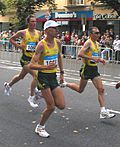This article needs additional citations for verification .(October 2024) |

Open water swimming is a swimming discipline which takes place in outdoor bodies of water such as open oceans, lakes, and rivers. [1] Competitive open water swimming is governed by the International Swimming Federation, World Aquatics (formerly known as FINA), except when it is part of multi-sport events, which are governed by the World Triathlon. Non-competitive open water swimming may be called wild swimming.
Contents
- Racing techniques
- Stroke
- Sighting
- Drafting
- Beach starting/exiting
- Equipment used in competitions
- Wetsuit usage
- Subcategories
- Recreational open-water swimming
- Competitions
- See also
- References
- Further reading
- External links
In the first edition of the modern Olympic Games in Athens in 1896, the swimming competition was held in open water. In 2000, the Olympic Games first included a triathlon with a 1500 m swim leg, and in 2008, a 10 km open water swim. The FINA World Aquatics Championships has featured open water swimming events since 1992. The FINA World Open Water Swimming Championships was held from 2000 to 2010. Since 2007, the FINA 10 km Marathon Swimming World Cup is held in several events around the world.
Events such as the Midmar Mile in South Africa (attributed to Wayne Ridden), the Great Swim in the UK (whose idea is attributed to Colin Hill), and the Batley race have helped create and grow interest and participation in the sport.







